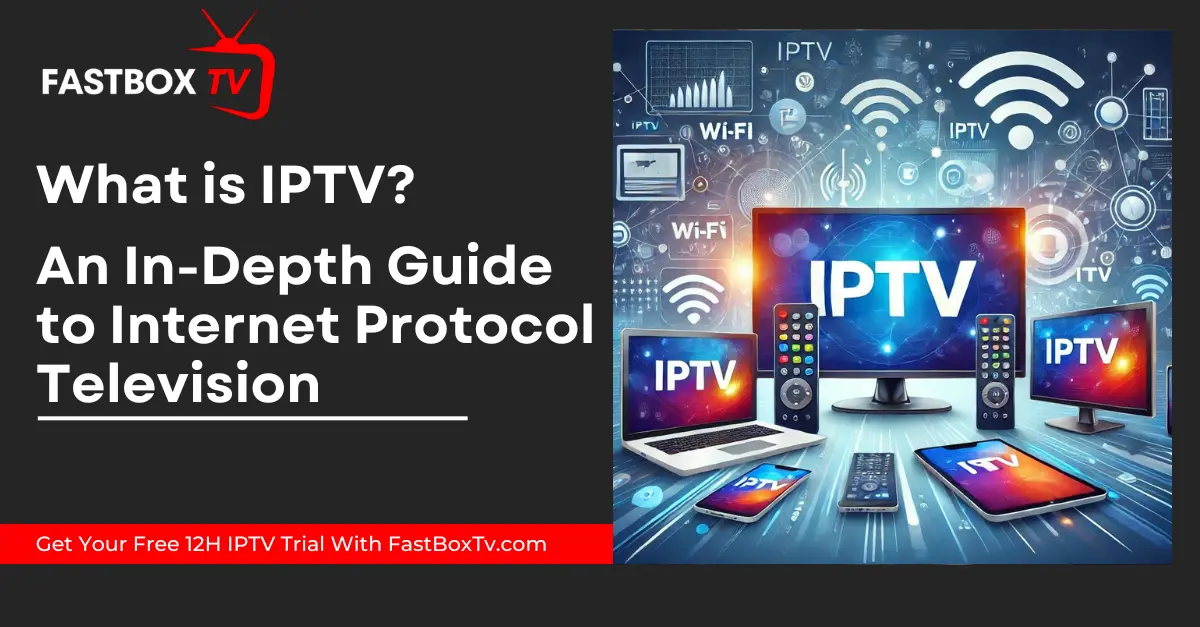Table of Contents
- Introduction to IPTV
- How Does IPTV Work?
- Benefits of IPTV
- Challenges and Considerations of IPTV
- How to Choose the Right IPTV Service
- Setting Up IPTV at Home
- Future of IPTV
- Conclusion
- Frequently Asked Questions (FAQ)
Introduction to IP TV
What Does IPTV Stand For?
IP TV stands for Internet Protocol Television. Unlike traditional television services that rely on satellite signals or cable connections, IP TV delivers television content over the internet using the Internet Protocol (IP). This fundamental difference allows IP TV to offer a more flexible and personalized viewing experience compared to conventional TV services.
In essence, IP TV converts television signals into data packets and transmits them over the internet. These data packets are then reassembled into video and audio streams on the user’s device. This technology enables users to watch live TV, on-demand content, and even time-shifted programs whenever they want, using a variety of devices including smart TVs, smartphones, tablets, and computers.
Why is IPTV Popular?
The popularity of IP TV has surged in recent years due to the increasing demand for on-demand content and the growing trend of cord-cutting, where consumers opt out of traditional cable or satellite TV subscriptions. IP TV offers several advantages that make it appealing to modern viewers:
- Flexibility: With IP TV, users can watch their favorite shows and movies on any device, whether at home or on the go. This flexibility is a significant advantage over traditional TV services that are typically tied to a single location.
- Personalization: IP TV allows users to customize their viewing experience by selecting specific channels or content packages that suit their preferences. This level of personalization is often lacking in traditional TV services.
- On-Demand Access: IP TV services offer a vast library of on-demand content, enabling users to watch movies, TV shows, and other videos whenever they want. This contrasts with the fixed schedules of traditional TV programming.
- Cost-Effectiveness: In many cases, IPTV services are more affordable than traditional cable or satellite TV subscriptions. This affordability, combined with the other benefits, has led to widespread adoption of IP TV.

How Does IPTV Work?
Understanding the Technology Behind IPTV
At its core, IP TV relies on the same underlying technology that powers the internet. The key difference is that instead of delivering web pages or files, IP TV delivers video content. Here’s how it works:
- Internet Protocol (IP): The “IP” in IP TV stands for Internet Protocol, which is the set of rules that governs how data is transmitted over the internet. In the context of IP TV, IP is used to deliver video content in the form of data packets that travel from the server to the user’s device.
- Streaming Protocols: IP TV uses various streaming protocols to transmit video content. These protocols include HTTP Live Streaming (HLS), Real-Time Streaming Protocol (RTSP), and Dynamic Adaptive Streaming over HTTP (DASH). These protocols ensure that the video content is delivered smoothly, with minimal buffering and latency.
- Content Delivery Networks (CDNs): To ensure efficient and reliable delivery of video content, IP TV services often use Content Delivery Networks (CDNs). CDNs are networks of servers distributed across different locations, designed to cache and deliver content to users based on their geographical location. This reduces the load on the main server and minimizes latency, providing a better viewing experience.
Components of an IPTV System
An IPTV system typically comprises the following components:
- IPTV Service Providers: These are the companies that offer IP TV services to consumers. They acquire the rights to broadcast TV channels and other content, which they then deliver to users over the internet.
- IPTV Set-Top Boxes: These devices connect to the user’s television and the internet, allowing them to access IP TV content. Set-top boxes decode the IP data packets into video and audio streams that can be displayed on the TV screen.
- IPTV Apps and Software: In addition to set-top boxes, IP TV services can be accessed via apps and software installed on smart TVs, smartphones, tablets, and computers. These apps provide the interface for browsing and watching content.
Types of IPTV Services
IP TV services can be categorized into three main types:
Live IPTV
Live IP TV is similar to traditional live television, where users can watch TV channels in real time as they are broadcast. Live IP TV is popular for watching sports events, news channels, and other live programming. Unlike traditional TV, live IP TV allows users to pause, rewind, and even record live broadcasts.
Video on Demand (VoD)
Video on Demand (VoD) refers to a service where users can select and watch video content whenever they want, rather than being restricted to a fixed broadcast schedule. VoD libraries typically include movies, TV shows, documentaries, and other types of video content. This on-demand nature of VoD is one of the key reasons for the popularity of IP TV.
Time-Shifted IPTV
Time-Shifted IPTV allows users to watch previously aired content at their convenience. This includes features like catch-up TV, where users can watch shows that aired earlier in the day or week, and start-over TV, which allows viewers to restart a live broadcast from the beginning. Time-shifting adds a layer of flexibility to the IPT V experience that traditional TV services cannot match.
Benefits of IPTV
Convenience and Flexibility
One of the most significant benefits of IP TV is the convenience and flexibility it offers to viewers. With IP TV, users are not tied to a specific device or location. They can watch their favorite shows and movies on any device with an internet connection, whether it’s a smart TV, smartphone, tablet, or computer. This flexibility is particularly beneficial for those who travel frequently or prefer to watch content on multiple devices.
Moreover, IP TV services typically offer cloud-based DVR functionality, allowing users to record shows and watch them later at their convenience. This eliminates the need for physical DVR devices and provides a seamless viewing experience across different devices.
Customization and Personalization
IPTV services often provide a high degree of customization and personalization. Users can choose from a wide range of channels and content packages, tailoring their subscriptions to their preferences. Some IP TV providers also offer personalized content recommendations based on viewing history and preferences, making it easier for users to discover new shows and movies.
Additionally, IP TV allows for the creation of custom playlists and favorites lists, enabling users to organize their content in a way that suits their needs. This level of personalization enhances the overall viewing experience, making IP TV a preferred choice for many consumers.
Cost-Effectiveness
IPTV can be a more cost-effective alternative to traditional cable or satellite TV services. Many IP TV providers offer competitive pricing, with subscription plans that are often lower than those of traditional TV services. Moreover, IP TV services typically do not require long-term contracts, allowing users to cancel or modify their subscriptions at any time without incurring penalties.
Additionally, there are free IPTV services available that provide access to a limited selection of channels and content. While these services may not offer the same range of features as paid subscriptions, they can be an attractive option for budget-conscious viewers.
High-Quality Streaming
IPTV services are known for their high-quality streaming capabilities. Many IP TV providers offer content in HD and 4K resolution, providing viewers with a superior visual experience. Additionally, IP TV services are designed to minimize buffering and latency, ensuring smooth and uninterrupted streaming even during peak usage times.
Some IP TV services also offer adaptive bitrate streaming, which automatically adjusts the video quality based on the user’s internet connection speed. This feature helps maintain a consistent viewing experience, even in areas with fluctuating internet speeds.
Challenges and Considerations of IPTV
Potential Technical Issues
While IP TV offers many advantages, there are also potential technical issues that users may encounter. One of the most common problems is buffering, which occurs when the video stream is interrupted due to insufficient bandwidth or network congestion. To minimize buffering, users should ensure that they have a stable and high-speed internet connection.
Another potential issue is compatibility. Not all devices support IP TV services, so users may need to invest in additional hardware, such as a set-top box or a compatible streaming device. Additionally, some IP TV services may require specific software or apps that are not available on all platforms.
Legal and Licensing Concerns
The legal status of IP TV services can vary depending on the region and the specific service provider. While many IP TV providers operate legally and acquire the necessary licenses to broadcast content, there are also unauthorized IP TV services that offer content without proper licensing. Using these services can expose users to legal risks, including fines and other penalties.
To avoid legal issues, users should choose reputable IP TV providers that operate within the bounds of the law. It’s also important to be aware of the licensing agreements for content in different regions, as some IP TV services may be restricted or unavailable in certain countries.
Dependence on Internet Connection
IPTV services are highly dependent on a stable and fast internet connection. Without a reliable internet connection, users may experience interruptions in their streaming, including buffering, freezing, or loss of signal. For optimal performance, IP TV typically requires a minimum internet speed of 5 Mbps for HD streaming and 25 Mbps for 4K streaming.
In areas with limited or unreliable internet access, IP TV may not be the best option. Users in such regions may need to explore alternative TV services that do not rely on the internet, such as traditional cable or satellite TV.


How to Choose the Right IPTV Service
Factors to Consider When Choosing an IPTV Provider
When selecting an IP TV provider, there are several factors to consider to ensure that you choose the right service for your needs:
- Channel Selection and Content Library: Consider the range of channels and content available. Does the provider offer the channels and shows you want to watch? Are there options for live TV, VoD, and time-shifted content?
- Pricing and Subscription Options: Compare the pricing of different IP TV providers. Look for plans that fit your budget and offer the best value for the content and features you need. Also, consider the flexibility of the subscription plans—can you cancel or change your plan easily?
- Customer Support and Service Reliability: Check the provider’s reputation for customer service and technical support. Are they responsive and helpful? Additionally, consider the reliability of the service—does it have a good track record for uptime and performance?
- Device Compatibility: Ensure that the IP TV service is compatible with the devices you plan to use, such as smart TVs, smartphones, tablets, and computers. If you need additional hardware, such as a set-top box, consider the cost and ease of setup.
Popular IPTV Service Providers
Here is a comparison table of some popular IPTV service providers:
| Provider | Price (Monthly) | Channel Selection | Device Compatibility | Free Trial |
|---|---|---|---|---|
| FastBox Tv | $29.99 | +65,000 Channels | Smart TVs, Android, iOS, PC | 12 Hours |
| CatchON TV | $20 | +15,000 Channels | Roku, Fire Stick, Apple TV, PC | 24 Hours |
| Tv World Access | $12.99 | +65,000 Channels | Android, iOS, PC | 12 Hours |
| Xtreme HD IPTV | $15.99 | +20,000 Channels | Smart TVs, Fire Stick, PC | 6 Hours |
This table provides a quick overview of some well-known IP TV providers, including their pricing, channel offerings, device compatibility, and whether they offer a free trial.
Free vs. Paid IPTV Services
When deciding between free and paid IPTV services, it’s essential to weigh the pros and cons of each:
Free IPTV Services:
- Pros:
- No cost involved
- Access to a limited selection of channels
- Suitable for casual viewers
- Cons:
- Limited content library
- Lower streaming quality
- Frequent ads and interruptions
- Potential legal risks with unauthorized services
Paid IPTV Services:
- Pros:
- Extensive channel selection and content library
- High-quality streaming (HD, 4K)
- Fewer ads and interruptions
- Reliable customer support
- Cons:
- Monthly subscription cost
- May require additional hardware
In general, paid IP TV services offer a more reliable and higher-quality experience, making them the preferred choice for most users.
Setting Up IPTV at Home
Step-by-Step Guide to Setting Up IPTV
Setting up IP TV at home is relatively straightforward, especially if you follow these steps:
- Choose an IPTV Provider: Start by selecting an IP TV provider that meets your needs. Consider the factors mentioned earlier, such as channel selection, pricing, and device compatibility.
- Select Your Device: Decide on the device you will use to watch IP TV. This could be a smart TV, smartphone, tablet, or computer. If your device is not compatible with the IP TV service, you may need to purchase a set-top box.
- Install IPTV App or Software: Download and install the IP TV app or software provided by your chosen service. This app will serve as the interface for browsing and watching content.
- Connect to the Internet: Ensure that your device is connected to a stable and high-speed internet connection. For the best experience, use a wired Ethernet connection rather than Wi-Fi.
- Set Up Channels and Preferences: Once the app is installed, set up your channels and preferences. This may include selecting your favorite channels, creating playlists, and adjusting settings such as video quality and subtitles.
- Start Watching: After setting up your channels and preferences, you’re ready to start watching IP TV. Browse the content library or tune in to live TV channels and enjoy the flexibility and convenience of IP TV.
IPTV-Compatible Devices
Here is a list of devices that are commonly compatible with IP TV services:
- Smart TVs: Most modern smart TVs come with built-in IP TV apps or support for third-party IPTV apps.
- Streaming Devices: Devices like Roku, Amazon Fire Stick, Apple TV, and Google Chromecast support IP TV apps and can be easily connected to your TV.
- Smartphones and Tablets: IP TV apps are available for both Android and iOS devices, allowing you to watch content on the go.
- Computers: IPTV can be accessed on both Windows and macOS computers through web browsers or dedicated IPT V software.
Troubleshooting Common IPTV Setup Issues
If you encounter issues during the IPTV setup process, here are some common problems and solutions:
- Buffering and Streaming Issues: Ensure that your internet connection meets the minimum speed requirements. If you’re using Wi-Fi, try switching to a wired Ethernet connection for more stable performance.
- Compatibility Problems: If your device is not compatible with the IP TV service, check if there is an alternative app or software available for your device. In some cases, you may need to purchase a set-top box.
- Channel Loading Problems: If channels are not loading, try restarting the app or device. If the problem persists, contact your IP TV provider for assistance.
- Login and Authentication Errors: Double-check your login credentials and ensure that your subscription is active. If you continue to experience issues, reach out to your provider’s customer support.


Future of IPTV
Trends in IPTV Technology
The future of IPTV is closely tied to advancements in technology. Several trends are expected to shape the IPTV landscape in the coming years:
- 5G Technology: The rollout of 5G networks will significantly improve the quality and speed of IPTV streaming, particularly in areas with previously limited internet access. 5G’s low latency and high bandwidth capabilities will enable seamless streaming of HD and 4K content, even in mobile environments.
- AI and Machine Learning: Artificial intelligence (AI) and machine learning are being increasingly integrated into IP TV services. These technologies allow for more accurate content recommendations, personalized user experiences, and enhanced search functionalities.
- Interactive TV: IPTV services are likely to become more interactive, offering features such as live polling, real-time social media integration, and interactive advertisements. These features will create a more engaging and immersive viewing experience.
Growth of IPTV Worldwide
The adoption of IPTV is growing rapidly worldwide, particularly in regions with high internet penetration and demand for on-demand content. Emerging markets in Asia, Latin America, and Africa are expected to see significant growth in IPTV subscriptions as internet access expands and consumer preferences shift toward streaming services.
According to industry forecasts, the global IPTV market is projected to grow at a compound annual growth rate (CAGR) of 16.9% from 2021 to 2028. This growth is driven by the increasing availability of high-speed internet, the rise of smart TVs, and the growing preference for personalized and on-demand content.
The Role of IPTV in the Evolution of Television
IPTV is playing a crucial role in the evolution of television. As traditional TV services face declining viewership, IPTV is emerging as the preferred alternative for many consumers. The ability to watch content on-demand, customize channel packages, and access content from any device is transforming how people consume television.
In the future, IPTV is expected to become even more integrated with other digital services, such as home automation and smart home devices. This integration will create a more cohesive and convenient entertainment experience, further solidifying IPTV’s position as the future of television.
Conclusion
IPTV is revolutionizing the way we watch television by delivering content over the internet, offering unprecedented flexibility, personalization, and convenience. As technology continues to advance, IPTV is poised to play an even more significant role in the evolution of television, providing viewers with more control over their viewing experiences than ever before.
Whether you’re looking to cut the cord, access a broader range of content, or simply enjoy the convenience of on-demand viewing, IPTV offers a compelling alternative to traditional TV services. By understanding how IPTV works, its benefits, challenges, and the factors to consider when choosing a provider, you can make an informed decision and fully embrace the future of television.
Frequently Asked Questions (FAQ)
What is the difference between IPTV and traditional TV?
IPTV delivers television content over the internet using Internet Protocol, whereas traditional TV relies on satellite, cable, or broadcast signals. IPTV offers more flexibility, allowing users to watch content on-demand and on various devices.
Is IPTV legal?
IPTV itself is legal, but the legality of specific IPTV services depends on whether they have the proper licenses to broadcast content. It’s important to choose reputable IPTV providers to avoid legal issues.
Can I use IPTV on multiple devices?
Yes, most IPTV services allow you to use their apps on multiple devices, such as smart TVs, smartphones, tablets, and computers. Some providers may have limits on the number of simultaneous streams.
What internet speed do I need for IPTV?
For HD streaming, a minimum speed of 5 Mbps is recommended, while 4K streaming typically requires at least 25 Mbps. A stable and fast internet connection is essential for a smooth IPTV experience.
Can I record shows on IPTV?
Many IPTV services offer cloud-based DVR functionality, allowing you to record shows and watch them later. This feature varies by provider, so it’s important to check if your chosen service includes it.




